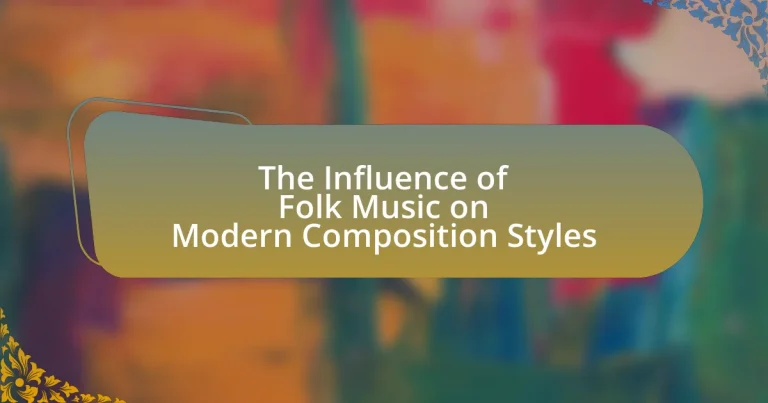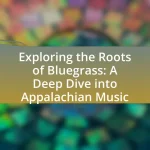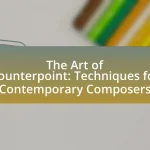The article examines the influence of folk music on modern composition styles, highlighting how traditional melodies, rhythms, and storytelling techniques shape contemporary music. It discusses the historical impact of folk music on notable composers like Béla Bartók and Aaron Copland, as well as the integration of folk elements in various modern genres, including country, bluegrass, and pop. Key characteristics of folk music, such as simplicity and cultural authenticity, are explored, along with the ways contemporary artists reinterpret folk narratives and themes in their works. The article emphasizes the importance of understanding folk traditions for composers seeking to enhance their creative processes and connect with cultural heritage.
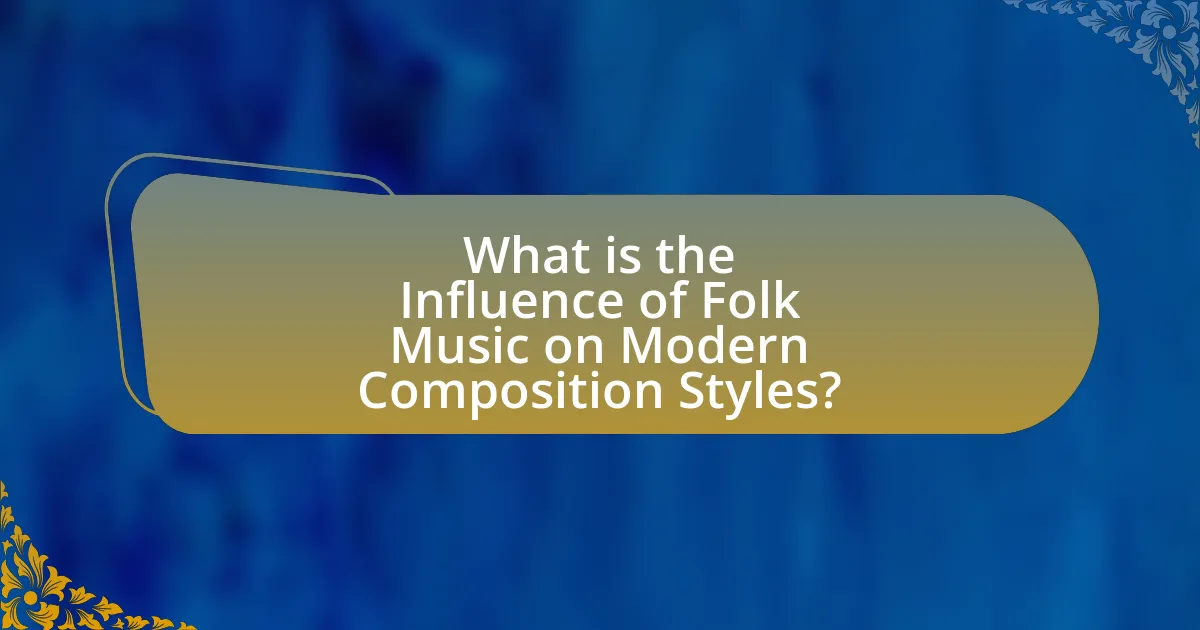
What is the Influence of Folk Music on Modern Composition Styles?
Folk music significantly influences modern composition styles by providing foundational elements such as melody, rhythm, and cultural storytelling. Many contemporary composers incorporate folk motifs and scales, drawing from diverse traditions to create a rich tapestry of sound. For instance, the use of pentatonic scales, common in various folk traditions, can be found in the works of modern artists like Béla Bartók and Aaron Copland, who integrated these elements to evoke a sense of place and identity. Additionally, the narrative quality of folk music informs the thematic development in modern compositions, allowing composers to explore cultural heritage and social issues through their works. This blending of folk influences with contemporary techniques demonstrates the enduring relevance of folk music in shaping the landscape of modern composition.
How has folk music historically shaped modern composition styles?
Folk music has historically shaped modern composition styles by providing foundational melodies, rhythms, and storytelling techniques that composers incorporate into their works. The integration of folk elements can be seen in the compositions of notable figures such as Béla Bartók and Aaron Copland, who drew inspiration from traditional folk songs to create innovative classical music. For instance, Bartók’s use of Hungarian folk themes in his orchestral works demonstrates how folk music can influence harmonic structures and thematic development. Additionally, the folk revival movements of the 20th century, particularly in the United States, led to a blending of folk traditions with contemporary genres, further solidifying folk music’s impact on modern composition.
What are the key characteristics of folk music that influence modern compositions?
Key characteristics of folk music that influence modern compositions include simplicity, storytelling, and cultural authenticity. Simplicity in folk music often manifests through straightforward melodies and harmonies, making it accessible and relatable, which modern composers adopt to create emotionally resonant pieces. Storytelling is a fundamental aspect of folk music, where narratives convey cultural values and experiences; this characteristic inspires contemporary songwriters to weave personal or societal tales into their works. Cultural authenticity, reflected in the use of traditional instruments and regional styles, encourages modern musicians to incorporate diverse sounds and techniques, enriching their compositions. These elements collectively shape the landscape of modern music, demonstrating the enduring impact of folk traditions.
In what ways do cultural contexts of folk music impact contemporary music creation?
Cultural contexts of folk music significantly impact contemporary music creation by providing thematic material, stylistic elements, and emotional resonance. Folk music often reflects the traditions, stories, and values of specific communities, which contemporary artists incorporate to create authentic narratives in their work. For instance, the use of traditional instruments, such as the banjo or fiddle, in modern genres like bluegrass or indie folk showcases how these cultural elements are adapted and reinterpreted. Additionally, the lyrical themes rooted in folk traditions, such as social justice or personal struggle, resonate with contemporary audiences, influencing songwriters to address similar issues in their music. Research indicates that artists who draw from folk traditions often achieve greater emotional connection with listeners, as evidenced by the popularity of artists like Mumford & Sons and The Lumineers, who blend folk influences with modern sounds to create relatable and impactful music.
Why is it important to study the influence of folk music on modern compositions?
Studying the influence of folk music on modern compositions is important because it reveals the roots and cultural significance embedded in contemporary music. Folk music often serves as a foundation for various genres, providing thematic material, melodic structures, and rhythmic patterns that shape modern compositions. For instance, many popular songs incorporate traditional folk elements, which can be traced back to specific cultural narratives and historical contexts, such as the use of Appalachian folk tunes in American bluegrass music. This connection not only enriches the understanding of modern music but also highlights the ongoing dialogue between past and present musical practices, demonstrating how cultural heritage continues to inform and inspire new artistic expressions.
What insights can be gained from understanding this influence?
Understanding the influence of folk music on modern composition styles reveals how traditional elements shape contemporary musical practices. This influence is evident in the incorporation of folk melodies, rhythms, and instruments into modern genres, which enhances cultural diversity and authenticity in music. For instance, artists like Bob Dylan and Mumford & Sons have successfully integrated folk elements, demonstrating that such influences can lead to innovative soundscapes while preserving cultural heritage. This blending not only enriches the listening experience but also fosters a deeper connection between audiences and the cultural narratives embedded in folk traditions.
How does this influence reflect societal changes over time?
The influence of folk music on modern composition styles reflects societal changes over time by showcasing the evolution of cultural identity and community values. As folk music often embodies the traditions, struggles, and narratives of specific communities, its integration into contemporary music illustrates how these communities adapt and respond to social transformations. For instance, the resurgence of folk elements in popular music during the 1960s coincided with social movements advocating for civil rights and anti-war sentiments, highlighting a collective desire for authenticity and connection to heritage. This trend indicates that as societies undergo significant shifts, such as urbanization or globalization, the incorporation of folk music serves as a means to preserve cultural roots while also addressing contemporary issues, thus mirroring the dynamic interplay between tradition and modernity.
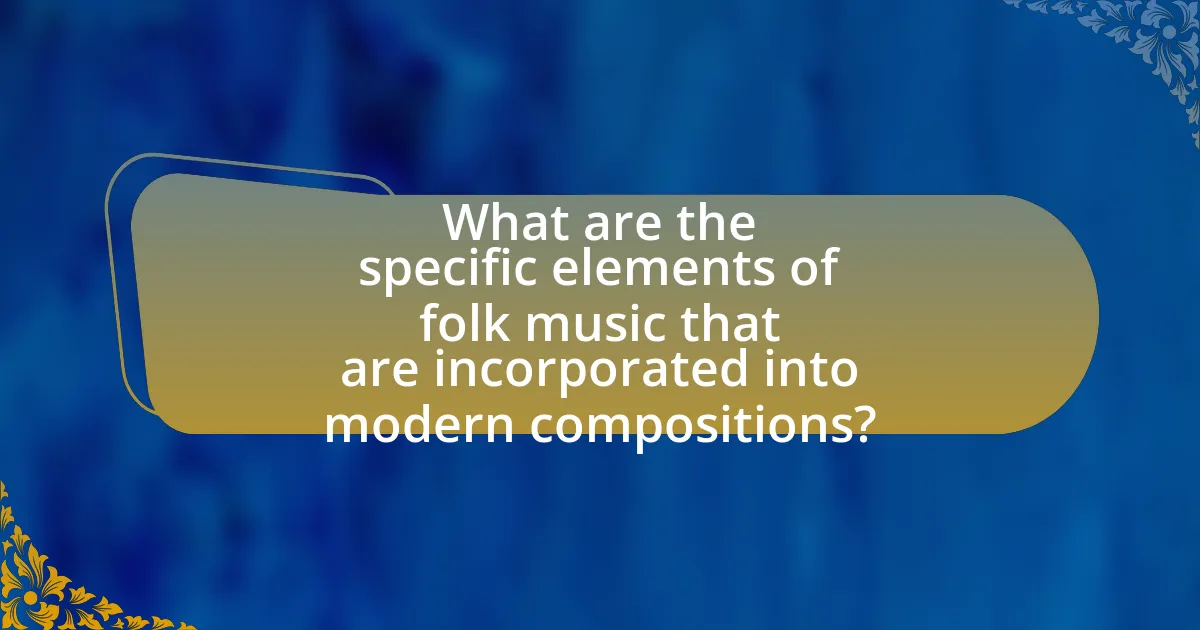
What are the specific elements of folk music that are incorporated into modern compositions?
Modern compositions incorporate specific elements of folk music, including traditional melodies, rhythmic patterns, and cultural storytelling. Traditional melodies often serve as the foundation for new works, allowing composers to evoke a sense of nostalgia and cultural identity. Rhythmic patterns from folk music, such as syncopation and simple time signatures, are frequently adapted to create accessible and engaging rhythms in contemporary pieces. Additionally, the narrative aspect of folk music, which conveys cultural stories and experiences, is often reflected in modern lyrics and thematic content, enhancing emotional resonance. These elements demonstrate the enduring influence of folk traditions on contemporary music, as seen in genres like folk-rock and world music fusion.
How do melodies and harmonies from folk music appear in modern works?
Melodies and harmonies from folk music appear in modern works through the incorporation of traditional scales, rhythmic patterns, and thematic material. Contemporary composers often draw inspiration from folk melodies, adapting them into new contexts, which can be seen in genres such as folk rock, world music fusion, and even classical compositions. For instance, artists like Bob Dylan and Simon & Garfunkel have integrated folk melodies into popular music, while composers like Béla Bartók and Aaron Copland have utilized folk themes to create classical pieces that reflect cultural heritage. This blending of folk elements with modern musical techniques demonstrates the enduring influence of folk music on contemporary composition styles.
What are some examples of modern compositions that utilize folk melodies?
Modern compositions that utilize folk melodies include “The Wound-Dresser” by Charles Ives, which incorporates American folk themes, and “Mason Bates’ Mothership,” which features elements of folk music from various cultures. Additionally, “Concerto for Orchestra” by Béla Bartók is renowned for its integration of Hungarian folk tunes. These works exemplify how contemporary composers draw inspiration from traditional melodies to create innovative musical experiences.
How do harmonic structures from folk traditions influence contemporary genres?
Harmonic structures from folk traditions significantly influence contemporary genres by providing foundational chord progressions and modal scales that shape modern music’s sound. For instance, many contemporary artists incorporate the pentatonic scale, prevalent in various folk traditions, which creates melodies that resonate with listeners due to their cultural familiarity. Additionally, the use of specific harmonic progressions, such as the I-IV-V pattern found in folk music, is frequently adapted in genres like rock, pop, and country, demonstrating a direct lineage from traditional to modern compositions. This influence is evident in the works of artists like Mumford & Sons and Fleet Foxes, who blend folk harmonies with contemporary styles, showcasing the enduring relevance of folk harmonic structures in today’s music landscape.
What role do lyrics and storytelling play in the fusion of folk and modern music?
Lyrics and storytelling serve as essential elements in the fusion of folk and modern music by preserving cultural narratives while adapting to contemporary themes. Folk music traditionally emphasizes storytelling, often reflecting social issues, personal experiences, and historical events, which resonates with audiences on an emotional level. Modern music incorporates these narrative techniques, allowing artists to connect with listeners through relatable themes and innovative soundscapes. For instance, artists like Bob Dylan and Mumford & Sons blend folk storytelling with modern instrumentation, creating a bridge between the past and present. This fusion not only revitalizes folk traditions but also enhances the depth and relatability of modern compositions, demonstrating the enduring power of lyrics and storytelling in music.
How do modern composers adapt folk narratives in their works?
Modern composers adapt folk narratives in their works by integrating traditional melodies, rhythms, and storytelling elements into contemporary musical forms. This adaptation often involves reinterpreting the original narratives to resonate with modern audiences while preserving the essence of the folk stories. For example, composers like Béla Bartók and Aaron Copland have utilized folk themes to create new compositions that reflect cultural identities and historical contexts, demonstrating how folk music can inform and enrich modern classical music. Their works often include specific folk motifs and structures, which serve as a bridge between the past and present, illustrating the ongoing relevance of folk narratives in contemporary music.
What themes from folk music are prevalent in today’s songwriting?
Themes from folk music that are prevalent in today’s songwriting include storytelling, social commentary, and a connection to nature. Storytelling remains a central element, as contemporary songwriters often weave personal narratives or historical tales into their lyrics, reflecting the folk tradition of passing down stories through song. Social commentary is also significant, with artists addressing issues such as inequality, identity, and political struggles, mirroring the folk genre’s roots in activism and reflection of societal challenges. Additionally, the theme of nature and the human experience within it continues to resonate, as many modern songs evoke imagery of landscapes, seasons, and the relationship between people and their environment, akin to traditional folk songs that celebrate rural life and natural beauty.

How do different genres of modern music incorporate folk influences?
Different genres of modern music incorporate folk influences through the integration of traditional melodies, instruments, and storytelling techniques. For example, country music often utilizes acoustic guitars and fiddles, drawing from American folk traditions, while indie rock frequently incorporates folk-inspired lyrical themes and instrumentation, as seen in the works of artists like Fleet Foxes. Additionally, hip-hop has embraced folk elements by sampling traditional folk songs or collaborating with folk musicians, exemplified by artists like Chance the Rapper who blend folk storytelling with contemporary beats. These integrations highlight the adaptability of folk music across various modern genres, enriching their sound and cultural narratives.
What genres are most influenced by folk music traditions?
Genres most influenced by folk music traditions include country, bluegrass, and folk rock. Country music often incorporates storytelling and acoustic instrumentation rooted in folk traditions, while bluegrass emphasizes string instruments and harmonies that reflect folk origins. Folk rock blends traditional folk elements with rock music, showcasing the adaptability of folk influences in contemporary styles. These genres demonstrate the lasting impact of folk music on modern composition, as they maintain core characteristics such as narrative lyrics and communal themes that are foundational to folk traditions.
How does folk music manifest in genres like pop, rock, and country?
Folk music manifests in genres like pop, rock, and country through the incorporation of traditional melodies, storytelling lyrics, and acoustic instrumentation. In pop music, artists often blend folk elements by using acoustic guitars and narrative-driven lyrics, as seen in the works of artists like Ed Sheeran, who integrates folk storytelling into mainstream pop. In rock, bands such as The Byrds and Mumford & Sons have utilized folk-inspired harmonies and instrumentation, creating a fusion that emphasizes roots music. Country music, deeply rooted in folk traditions, often features themes of rural life and personal experiences, with artists like Johnny Cash and Kacey Musgraves drawing directly from folk influences in their songwriting and sound. This blending of folk elements across these genres highlights the enduring impact of folk music on contemporary musical styles.
What are the unique adaptations of folk elements in electronic music?
Unique adaptations of folk elements in electronic music include the incorporation of traditional melodies, rhythms, and instruments into digital soundscapes. Artists often sample folk music or use folk-inspired motifs to create a fusion that retains the cultural essence while utilizing modern production techniques. For instance, the use of traditional instruments like the fiddle or accordion, processed through synthesizers and effects, allows for a blend of acoustic and electronic textures. This approach not only preserves the authenticity of folk traditions but also expands their reach to contemporary audiences, as seen in the works of artists like Bon Iver and ODESZA, who integrate folk influences into their electronic compositions.
How do contemporary artists reinterpret folk music in their compositions?
Contemporary artists reinterpret folk music in their compositions by blending traditional elements with modern genres, creating innovative soundscapes. This fusion often involves incorporating folk melodies, instruments, and storytelling techniques while integrating contemporary styles such as pop, rock, or electronic music. For example, artists like Sufjan Stevens and Fleet Foxes utilize traditional folk structures and themes but enhance them with modern production techniques and diverse instrumentation, resulting in a fresh take on folk traditions. This approach not only preserves the essence of folk music but also makes it accessible to new audiences, demonstrating its evolving nature in the contemporary music landscape.
What techniques do artists use to blend folk and modern styles?
Artists blend folk and modern styles using techniques such as instrumentation, rhythmic variation, and thematic integration. By incorporating traditional folk instruments like the banjo or fiddle alongside modern electronic elements, artists create a unique sound that honors both genres. Rhythmic variation allows for the fusion of folk’s organic beats with contemporary rhythms, enhancing the overall texture of the music. Additionally, thematic integration involves weaving folk narratives and motifs into modern lyrical frameworks, which enriches the storytelling aspect of the composition. This approach has been evidenced in works by artists like Mumford & Sons and Fleet Foxes, who successfully merge these elements to create a distinct musical identity.
How do collaborations between folk and modern musicians enhance this influence?
Collaborations between folk and modern musicians enhance the influence of folk music on contemporary composition by blending traditional elements with modern techniques, creating innovative soundscapes. This fusion allows for the preservation of folk traditions while making them accessible to a broader audience, thereby increasing their relevance in today’s music scene. For instance, artists like Mumford & Sons have successfully integrated folk instrumentation and melodies into mainstream pop, resulting in chart-topping hits that resonate with diverse listeners. Such collaborations not only introduce folk music to new genres but also inspire modern musicians to incorporate authentic cultural narratives into their work, enriching the overall musical landscape.
What practical tips can composers use to incorporate folk music into their modern compositions?
Composers can incorporate folk music into their modern compositions by studying traditional folk melodies and rhythms, which serve as a foundation for new works. By analyzing the structure and characteristics of folk music, such as its use of specific scales, modes, and instrumentation, composers can create authentic-sounding pieces that resonate with cultural heritage. For instance, utilizing pentatonic scales common in various folk traditions can evoke a sense of nostalgia and connection to the past. Additionally, integrating folk instruments, like the fiddle or accordion, can enhance the authenticity of the composition. Research shows that blending these elements not only enriches the musical texture but also broadens the emotional impact of the work, as seen in the compositions of modern artists like Béla Bartók, who effectively fused folk elements with classical techniques.
How can understanding folk traditions improve a composer’s creative process?
Understanding folk traditions can significantly enhance a composer’s creative process by providing a rich source of melodic, rhythmic, and harmonic ideas that are culturally rooted. Folk traditions often encapsulate unique scales, modes, and storytelling techniques that can inspire original compositions. For instance, the use of pentatonic scales in various folk music styles can lead to distinctive melodic lines that differ from conventional Western music. Additionally, incorporating traditional rhythms can add complexity and authenticity to a composer’s work, as seen in the integration of African polyrhythms in contemporary classical music. This blending of folk elements not only broadens a composer’s stylistic palette but also fosters a deeper connection to cultural narratives, enriching the emotional depth of their compositions.
What resources are available for composers looking to explore folk influences?
Composers looking to explore folk influences can access a variety of resources, including ethnomusicology databases, folk music archives, and instructional books. Ethnomusicology databases, such as the Smithsonian Folkways Recordings, provide extensive collections of traditional music from various cultures, allowing composers to study authentic folk sounds. Folk music archives, like the Library of Congress’s American Folklife Center, offer recordings, field notes, and transcriptions that can inspire new compositions. Additionally, instructional books, such as “The Study of Ethnomusicology: Thirty-One Issues and Concepts” by Bruno Nettl, provide theoretical frameworks and practical approaches to integrating folk elements into modern compositions. These resources collectively support composers in understanding and incorporating folk influences into their work.
